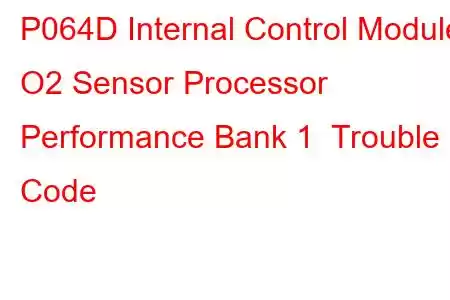P064D Internal Control Module O2 Sensor Processor Performance Bank 1
OBD-II Trouble Code Technical Description
Internal Control Module O2 Sensor Processor Performance Bank 1
What does that mean?
This is a generic powertrain diagnostic trouble code (DTC) and typically applies to OBD-II vehicles. That may include but is not limited to vehicles from Ford, Mazda, Smart, Land Rover, Dodge, Ram, etc. Although generic, the exact repair steps may vary depending on year, make, model and powertrain configuration.
When a code P064D is stored, it means that the powertrain control module (PCM) has detected an internal processor performance error with the heated oxygen sensor (HO2S) circuit for engine bank one. Other controllers may also detect an internal PCM performance error (with the HO2S circuit for bank one)) and cause a P064D to be stored.
Bank 1 denotes the bank of the engine which contains the number one cylinder.
The HO2S is composed of a zirconium dioxide sensing element and a tiny sample chamber enclosed within a vented steel housing. The sensing element is connected to wire leads in the HO2S wiring harness with small platinum electrodes. The HO2S wiring harness is connected to the engine control harness which provides the PCM with data pertaining to the percentage of oxygen in the engine exhaust compared to the oxygen content of ambient air.
The upstream HO2S sensor is located in the exhaust downpipe (between the exhaust manifold and the catalytic converter). The most common method of accomplishing this is by inserting the sensor directly into a threaded boss that is welded into the exhaust pipe. The threaded boss is placed in the downpipe at the most convenient position and angle for access and optimum sensor functionality. Removal and installation of threaded oxygen sensors will require specially designed wrenches or sockets, depending upon vehicle application. The HO2S may also be secured using threaded studs (and nuts) welded to the exhaust pipe.
Exhaust gases are pushed through the exhaust manifold and into the downpipe where they pass over the upstream HO2S. Exhaust gases flow through specially designed vent holes in the steel HO2S housing and across the sensing element. Ambient air is drawn into a small sample chamber in the center of the sensor, through the wire lead openings. In this chamber the air is heated, forcing the ions to produce (energy) voltage. Variations between the concentration of oxygen molecules in the exhaust and the ambient air (drawn into the HO2S) create fluctuations in the concentration of oxygen ions (inside the sensor). These fluctuations cause the oxygen ions (inside the HO2S) to bounce (rapidly and repetitiously) from one platinum layer to the other. As the surging ions of oxygen move between platinum layers it causes changes in voltage. These changes in voltage are recognized by the PCM as variations in exhaust oxygen concentration and reflect whether the engine is running lean (too little fuel) or rich (too much fuel). When more oxygen is present in the exhaust (lean condition) the voltage signal output from the HO2S is lower. When less oxygen is present in the exhaust (rich condition) the voltage signal output is higher. This data is used by the PCM to calculate fuel delivery strategy and ignition timing, among other things.
The upstream HO2S usually fluctuates between 100 and 900 millivolts (.1 and .9 volts), when the engine is idling and the PCM is in closed loop operation. In closed loop operation, the PCM considers input signals from upstream HO2S sensors to regulate fuel injector pulse width and (ultimately) fuel delivery. When the engine enters open loop operation (during cold start conditions and wide open throttle), fuel delivery strategy is preprogrammed.
Internal control module monitoring processors are responsible for various controller self-test duties and overall internal control m
Read: 42


